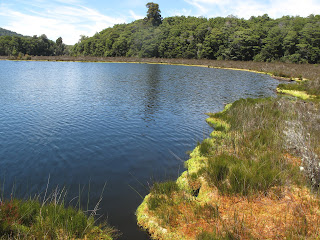We began our road trip driving down the west coast of the south island. The first stop was Punakaiki, an odd geological formation that has risen from the sea floor. Punakaiki is known as the “pancake rocks” due to the rocks flattened appearance.
 |
Sunset on the first night was spent at Punakaiki
The next stop was the glacier region. We viewed both Franz Josef and Fox Glacier in the same day. Franz Josef is impressive and stretches far up the mountain. Every few minutes a helicopter flys tourists and hikers high up on the glacier. Far below, large groups outfitted in snow gear are led by guides (iceaxes in-hand) to the face where they will hike up the glacier for a few hours. At Fox, the glacier seemed to be less commercialized and required an hour or so long walk to the Fox Glacier viewpoint. The view was great and you could view the glacier from a much higher viewpoint than at Franz Josef. |
 |
| Franz Josef Glacier |
 |
| Fox Glacier |
The next stop was Lake Matheson, which is famous for the reflected views of Mt. Cook in the lake's dark waters, unfortunately for us, the mountain was shrouded by clouds the day we visited. The lake circuit takes under 2 hours to complete but provides ample scenic viewpoints.
 |
| Cloud hide Mt Cook in the background |
 |
| A fern frond unfurling |
After lake Matheson the road began winding into the mountains with a quick roadside stop called the Blue Pools, which I remembered from my last visit. The Blue Pools are a congregation point for large trout during the winter months that swim up from lake Wanaka. The pools are deep, blue, and cold.
Following the highway we wove through the mountains and into the Wanaka area. As pulled into our campsite for the we noticed a problem with our car horn. The horn would inexplicably honk when we hit a pot hole or closed a car door. Later we figured out that it was any vibration that caused the non-stop blaring noise, but we only figured this out after waking up everyone at the campsite in the early morning to their delight.
 |
| A meadow passing into Wanaka |
The first hike we did was in Mt Aspiring National Park to the Rob Roy glacier. The track starts at the end of brutal 25km teeth chattering unpaved road. The track track then weaves through sheep pastures, across a long a windy swing bridge and up above a large meadow bisected by a river. Then climbing rapidly it moves into beech and fern forests and finally to a viewpoint for the Rob Roy Glacier. The viewpoint is a great spot to stop and enjoy your lunch, which is what the Kea's are counting on.
 |
| A close-up of Rob Roy, a hanging glacier |
The Kea is a large parrot and the only alpine parrot in the world. Kea's have built a reputation as clever and amusing birds that are undaunted by humans and will approach to get a snack. They are also notorious for destroying cars in parking lots by pulling at windshield wipers, mirrors, and anything they can get their beaks at.
 |
| A Kea with Rob Roy in the background |














































